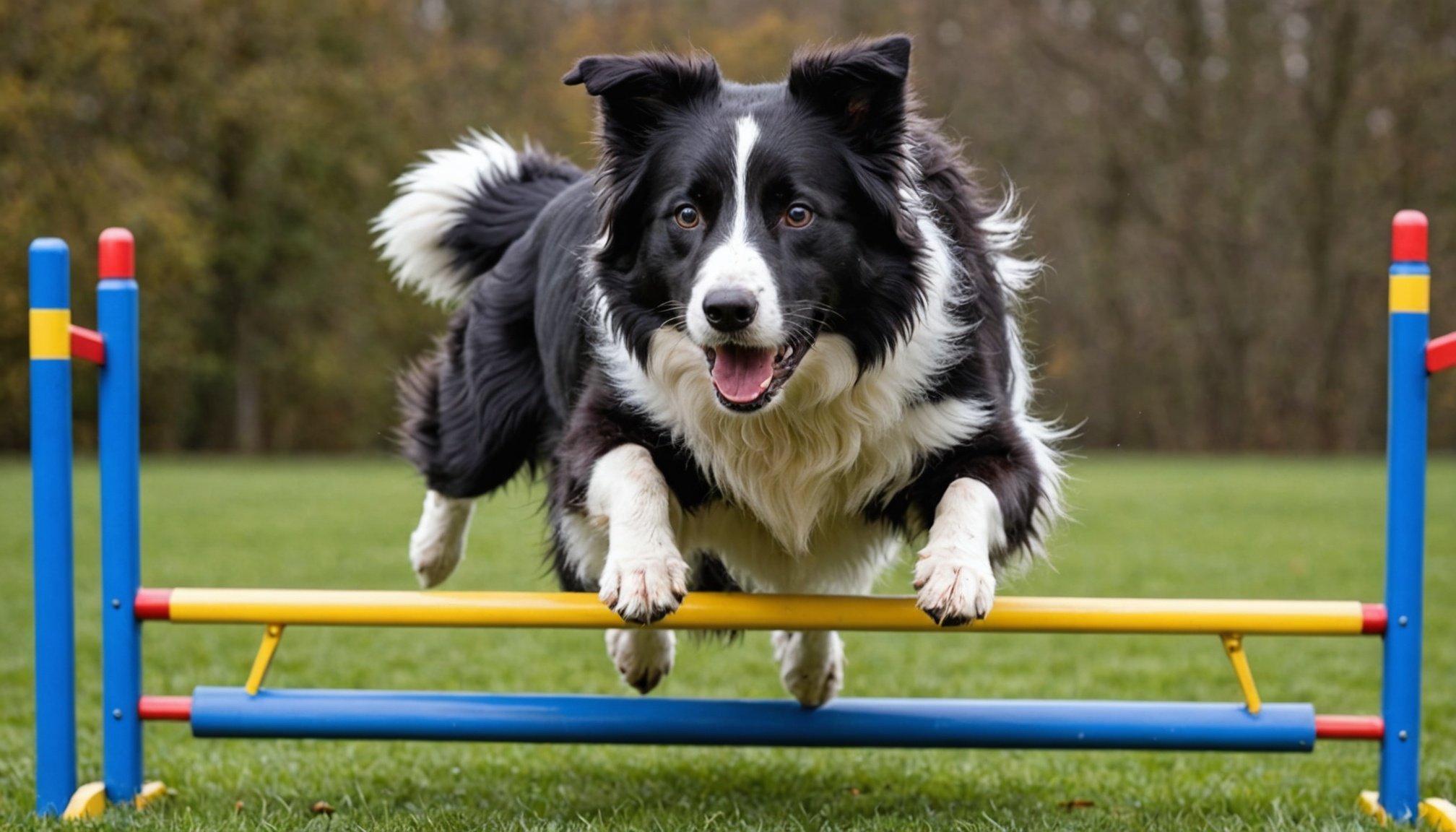Mastering Competitive Agility: A Guide to Training Your Border Collie for Success
Understanding the Sport of Agility
Agility is a dynamic and exciting dog sport that requires a strong bond between the dog and its handler, as well as a combination of physical skill, mental focus, and teamwork. For Border Collies, known for their intelligence, athleticism, and high energy levels, agility can be a perfect outlet. Here’s why agility is an excellent choice for your Border Collie:
- Physical Exercise: Agility courses are designed to challenge dogs physically, providing them with the exercise they need to stay healthy and happy.
- Mental Stimulation: The complex sequences and obstacles in agility courses offer mental stimulation, keeping your dog engaged and focused.
- Bonding: Agility training strengthens the bond between you and your dog, fostering trust, communication, and mutual respect.
Setting Your Dog Up for Success
Before diving into the intricacies of agility training, it’s crucial to set your dog up for success. Here are some key steps to follow:
Also to discover : Creating the Perfect Healing Haven: A Guide to Setting Up an Ideal Recovery Space for Your Post-Surgery Pet
Start Small and Build Gradually
Agility training should be fun and stress-free. Begin with simple obstacles and gradually increase the complexity as your dog becomes more confident and skilled. According to Arlene Spooner, Senior Agility Field Representative, “Keep it fun and stop before your dog loses interest.”
Use Positive Reinforcement
Positive reinforcement is the cornerstone of effective dog training. Use treats, praise, and affection to reward your dog for successful attempts at obstacles. This method not only builds trust but also encourages your dog to learn quickly and enthusiastically.
Also to read : Mastering Canine Adaptability: Tips for Teaching Your Dog to Thrive in Various Environments
Keep Training Sessions Short
Early training sessions should be no more than five to ten minutes long. This helps maintain your dog’s focus and prevents fatigue. As your dog becomes more engaged, you can gradually increase the duration of the sessions.
Building Foundation Skills
Before your Border Collie can tackle a full agility course, they need to master several foundation skills.
Teach Tricks and Basic Obedience
Tricks like “Watch Me” or “Look” help your dog focus on you despite distractions. Other useful tricks include teaching your dog to touch their nose to your hand or a target, walk backward, and jump through a hoop. These tricks enhance coordination, confidence, and body awareness, all of which are essential for agility.
Improve Handling Skills
Handling is a critical aspect of agility. Teach your dog to work comfortably on either side of you, jog, and run while staying on the indicated side. Use treats to motivate them to switch sides when commanded. Additionally, practice sending your dog away from you to the left or right and having them wrap around objects like cones or barrels.
Creating a Home Agility Course
You don’t need a professional agility course to start training your Border Collie. Here’s how you can create a makeshift course at home:
Utilize Household Items
Use items like cardboard boxes, plastic bins, and ladders to create obstacles. For example, you can lay a ladder flat on the ground and encourage your dog to step through the rungs. This helps them think about each footstep and builds their agility skills.
Set Up Tunnels and Jumps
Tunnels and jumps are fundamental obstacles in agility courses. You can create tunnels using cardboard boxes or PVC pipes and set up jumps using broom handles and small hurdles.
Practice Weave Poles
Weave poles are a challenging but rewarding obstacle. Start by setting up just a few poles and gradually increase the number as your dog becomes more proficient. You can use PVC pipes or even bamboo sticks to create a weave pole setup.
Advanced Training Techniques
Once your Border Collie has mastered the basics, it’s time to move on to more advanced training techniques.
Sequencing Obstacles
Sequencing involves teaching your dog to navigate a series of obstacles in a specific order. Start with simple sequences and gradually increase the complexity. Use verbal cues and body language to guide your dog through the course.
Contact Zones and Pause Tables
Teach your dog to enter contact zones at the end of obstacles like A-frames and dog walks. Use targets and verbal cues to guide them. The pause table is another critical obstacle where your dog must stop and sit or lie down for a few seconds before continuing. Practice this by using a sturdy box or footstool and rewarding your dog for staying in position.
Mental and Physical Conditioning
Agility training is not just about physical exercise; it also requires mental focus and conditioning.
Mental Stimulation
Agility provides excellent mental stimulation, but you can also incorporate other activities to keep your dog’s mind active. Teach new tricks, engage in scent work, or play interactive games like hide-and-seek.
Physical Conditioning
Physical conditioning is crucial for agility dogs. Incorporate exercises that boost strength, balance, and flexibility. For example, you can use workout plans that include exercises like walking backward, climbing inside boxes, and crawling through tunnels. These exercises help minimize injury risk and enhance overall performance.
Preparing for Agility Competitions
If you and your Border Collie are ready to take the leap into competitive agility, here are some tips to help you prepare:
Practice Under Distractions
Agility competitions can be distracting, so it’s essential to practice your training sessions in various environments with different distractions. This helps your dog focus on you despite the noise and commotion.
Master the Start Line
The start line is a critical part of any agility course. Teach your dog to stay in a start line position until you release them. Practice this by using verbal cues and rewards for staying in position.
Learn Course Maps
Familiarize yourself with course maps to understand the sequence of obstacles and plan your strategy. This helps you guide your dog more effectively during competitions.
Table: Comparing Key Aspects of Agility Training Programs
| Program Aspect | Dogs4Motion Academy | American Kennel Club | Dog Training Elite |
|---|---|---|---|
| Focus | Agility and fitness | General agility training | Comprehensive dog training |
| Training Style | Positive reinforcement | Positive reinforcement | Positive reinforcement |
| Course Structure | Online workout plans | Home-based training | In-home and specialized programs |
| Equipment | DIY and professional equipment | DIY and makeshift equipment | Professional equipment |
| Level of Expertise | Beginner to advanced | Beginner | Beginner to advanced |
| Additional Services | Conditioning courses, massage | General dog training tips | Service Animal and Therapy Dog training |
Quotes and Insights from Experts
- “Keep it fun and stop before your dog loses interest.” – Arlene Spooner, Senior Agility Field Representative
- “The morals of this story are that if the reward is good enough, the dog will work to earn that reward, and, second, what is one dog’s most valued reward may not be another’s.” – Board-certified behavior experts, Decoding Your Dog
- “Methods using force or compulsion have been proven to harm the human/animal bond and cause more problems for the dog and owner.” – Erica Marshall, CPDT-KA, CDBC
Practical Tips and Actionable Advice
Start Early
Begin training your puppy early to establish a strong foundation for agility. This helps in building teamwork and increasing body awareness from the outset.
Be Patient
Every dog learns at their own pace. Be patient and adjust your training sessions according to your dog’s comfort and skill level.
Use Visual Cues
Visual cues are essential in agility training. Use hand signals and body language to guide your dog through the course, especially in noisy environments.
Stay Positive
Maintain a positive and encouraging attitude during training sessions. This helps keep your dog motivated and engaged.
Training your Border Collie for agility is a rewarding journey that enhances your bond, provides physical and mental stimulation, and offers a fun and challenging activity for both you and your dog. By starting small, using positive reinforcement, creating a home course, and advancing to more complex training, you can set your dog up for success in this exciting sport. Remember to stay patient, positive, and always keep the training sessions fun and engaging.
With the right approach and dedication, you and your Border Collie can master the art of agility and enjoy the many benefits it has to offer. Whether you’re aiming for competitive agility or just looking for a fun way to spend time with your pet, agility training is an excellent choice for any dog owner. So, get started today and watch your Border Collie thrive in this dynamic and engaging sport.











